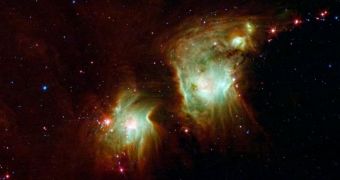During a recent scientific study, astronomers were able to calculate the vibration patterns of triatomic hydrogen ions (H3+), a molecule that is believed to have permeated the Universe just after the Big Bang. By completing this study, the team basically developed a way of detecting the chemical.
This work is essential for our understanding of the early Universe, experts from the University of Arizona say. It may go a long way towards explaining how the first stars came to be.
H3+ is made up of three hydrogen atoms, which only have 2 electrons among themselves. By figuring out how it vibrates, scientists are now able to predict what type of wavelengths it emits as light.
What this means is that spectrographs aboard all telescopes aimed at the sky will be able to distinguish its spectral lines from those produced by other elements, map its distribution in space, and conduct an entire series of related astronomical inquiries.
In addition, this compound is believed to have been the predominant form of normal, baryonic matter in the early Universe, some 13.7 billion years ago. Therefore, it most likely played a critically important role in the development of the first stars.
“Most of the Universe consists of hydrogen in various forms, but the H3+ ion is the most prevalent molecular ion in interstellar space. It's also one of the most important molecules in existence,” explains UA chemist Ludwik Adamowicz, quoted by Space.
One of the most important roles that H3+ probably played early on in the evolution of the Cosmos was that of a heat transfer medium. This in turn enabled the very first stars that were in the process of forming to continue doing so without overheating and exploding.
Together with former UA graduate student Michele Pavanello, Adamowicz developed a series of computer simulations covering the behavior of H3+ in the early Cosmos. The models also take into account the compound's behavior under the laws of quantum mechanics.
“There wouldn't be any star formation if there weren't molecules that slowly cool down the forming star by emitting light. Astronomers think that the only molecule that could cool down a forming star in that particular time is H3+,” Pavanello concludes.
Details of the study and its results were published in a recent issue of the esteemed scientific journal Physical Review Letters.

 14 DAY TRIAL //
14 DAY TRIAL //